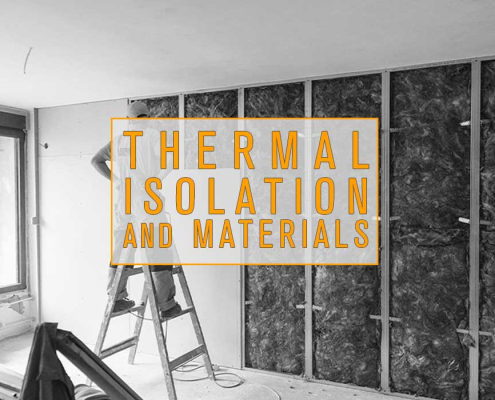Acoustic Isolation in Architecture: A Guide to Choosing the Best Materials
Entry published by: Francisco Joaquín Jiménez González. Registered architect and PassivHaus designer
In modern architecture, creating spaces that are both functional and comfortable involves more than just designing visually appealing structures. One key element often overlooked is acoustic isolation, which plays a vital role in ensuring that buildings provide a quiet, peaceful environment. Whether in homes, offices, or public buildings, controlling noise levels is essential for comfort, productivity, and well-being.
At Leukos Arquitectura, we’ve helped many clients tackle acoustic challenges by advising on the right soundproofing materials and techniques for their specific needs. In this guide, I’ll walk you through the fundamentals of acoustic insulation, compare different materials, and provide tips on how to achieve the best soundproofing for any space.
What Is Acoustic Isolation and Why Is It Important?
Acoustic isolation refers to the ability of a building or material to block or reduce the transmission of sound between spaces. This is especially important in urban environments, where external noise such as traffic, construction, and neighboring activities can easily infiltrate buildings, disrupting the comfort of those inside.
In addition, soundproofing is crucial in environments where sound quality is a priority—like recording studios, concert halls, or auditoriums. It’s also essential in multi-residential buildings to prevent noise from traveling between apartments, or in office settings to minimize distractions and protect privacy.
How Sound Travels in Buildings
Before diving into materials, it’s important to understand how sound travels within a building. Sound can travel through three main pathways:
- Airborne Sound: This includes noise that travels through the air, such as voices, music, or traffic noise.
- Structure-borne Sound: Vibrations caused by footsteps, slamming doors, or machinery can travel through walls, floors, and ceilings.
- Flanking Sound: Sound that travels around or through building elements that are not adequately insulated.
Effective acoustic isolation must address all three types of sound transmission by using a combination of mass, damping, decoupling, and absorption techniques. At Leukos Arquitectura, we carefully assess each project to determine which combination of solutions will best suit the space and its specific acoustic challenges.
How We Approach Acoustic Isolation at Leukos Arquitectura
When working with clients, the first step is to perform a thorough acoustic assessment of the space. This involves identifying noise sources, understanding how sound travels within the building, and evaluating the materials and construction techniques that are already in place.
Based on this assessment, we recommend materials and strategies tailored to the specific acoustic needs of the project. For example, a home near a busy road might require heavy, sound-blocking insulation in exterior walls, while an office building might benefit from sound-absorbing materials in partition walls to reduce noise between rooms.
Key Factors in Acoustic Isolation
When selecting materials for soundproofing, there are several key factors to consider:
- Sound Transmission Class (STC): This rating measures a material’s ability to block airborne sound. The higher the STC rating, the better the material is at preventing sound from passing through walls, floors, and ceilings.
- Noise Reduction Coefficient (NRC): This rating indicates how much sound a material can absorb. It’s especially important for controlling echo and improving the acoustics of a room.
- Material Density: Heavier materials tend to block sound more effectively, as they provide more mass to prevent sound waves from passing through.
- Flexibility and Damping: Some materials, such as viscoelastic layers, help dampen vibrations and reduce structure-borne noise.
- Acoustic bridges: It is always a good practice to assess the project as a whole and trying to review what points are more dangerous and what elements need to be overseen in order to avoid points where the noise can enter within our building/space.
Comparing Acoustic Materials
Now, let’s take a look at some of the most commonly used materials for acoustic isolation and how they compare in terms of soundproofing and absorption.
1. Acoustic Insulation Wool (Mineral Wool and Fiberglass)
Both mineral wool and fiberglass are commonly used in walls, ceilings, and floors for soundproofing. They are highly effective at absorbing sound and are widely available at a reasonable cost.
- STC Rating: Typically ranges from 45 to 60, depending on the thickness and density.
- NRC Rating: Ranges from 0.7 to 1.0, meaning they are excellent at absorbing sound and reducing reverberation.
- Pros: Great for absorbing sound, fire-resistant, easy to install.
- Cons: Requires additional layers, such as drywall or plasterboard, to block airborne sound more effectively.
In my experience at Leukos Arquitectura, we often use mineral wool in combination with drywall in interior partition walls to improve sound absorption and reduce noise between rooms.
Mineral wool has many benefits apart from acoustic isolation. It is also a very good thermal isolation material and it is fireproofed.
2. Mass-Loaded Vinyl (MLV)
Mass-loaded vinyl is a heavy, flexible material that can be added to walls, ceilings, and floors to block sound transmission. Its high density makes it one of the best materials for adding mass to a structure without taking up too much space.
- STC Rating: Ranges from 25 to 35 when used as a standalone layer but can be combined with other materials to increase effectiveness.
- Pros: Highly effective for airborne noise, relatively thin, easy to install as a layer between drywall or under flooring.
- Cons: More expensive than other options, does not absorb sound but blocks it.
For projects where space is a concern but high levels of soundproofing are required, MLV is an excellent choice. We frequently recommend it for home theaters or music studios where blocking external noise is critical.
3. Acoustic Panels and Foam
Acoustic foam and fabric-wrapped panels are primarily used for sound absorption rather than soundproofing. They are ideal for controlling echo and improving the acoustics of a room by reducing reverberation.
- STC Rating: Low, as these materials do not block sound but absorb it.
- NRC Rating: Ranges from 0.5 to 0.9, depending on the thickness and material.
- Pros: Lightweight, affordable, and easy to install on walls or ceilings.
- Cons: Not effective for blocking sound transmission; best used in combination with other soundproofing methods.
We typically use acoustic panels in conference rooms or offices to improve the overall acoustic environment, making it easier for people to hear each other without echoes or excessive background noise.
4. Green Glue Damping Compound
Green Glue is a noise-damping material applied between layers of drywall or other building materials to reduce structure-borne noise. It works by converting sound energy into heat, thereby reducing vibrations.
- STC Rating: Can increase the STC of a standard drywall assembly by 10 to 15 points.
- Pros: Highly effective at reducing impact noise, easy to apply in renovations or new construction.
- Cons: Requires additional construction work, such as adding extra drywall layers.
In projects where reducing impact noise is a priority—such as apartment buildings or hotels—we often recommend using Green Glue to create a quieter, more comfortable living environment.
5. Acoustic Glass
Acoustic glass consists of two or more panes of glass with an acoustic interlayer, providing both soundproofing and insulation. It’s most commonly used in windows and doors to reduce external noise, such as traffic or construction sounds.
- STC Rating: Typically ranges from 35 to 45, depending on the thickness of the glass and the interlayer.
- Pros: Effective at reducing external noise, also provides thermal insulation.
- Cons: More expensive than standard glass, may require professional installation.
For projects where exterior noise is a major concern—such as buildings near airports or busy roads—acoustic glass can be an essential component of the soundproofing strategy.
Best Practices for Acoustic Isolation in Architecture
At Leukos Arquitectura, we believe that achieving the best acoustic isolation requires a combination of materials and techniques, tailored to the specific needs of the building. Here are some of the best practices we follow:
- Use a Layered Approach: Combining different materials, such as mineral wool, MLV, and Green Glue, can provide more effective soundproofing than any single material alone.
- Address Both Airborne and Structure-Borne Sound: Ensure that your soundproofing strategy addresses all forms of sound transmission by using a mix of mass, damping, and decoupling techniques.
- Seal Gaps and Cracks: Even the best soundproofing materials will be less effective if there are gaps in the construction. Use caulk or acoustic sealant to seal any cracks around windows, doors, or electrical outlets.
- Consider the Building’s Purpose: In spaces like offices, schools, or hospitals, where speech intelligibility is important, focus on materials that absorb sound and reduce reverberation. For home theaters or recording studios, prioritize materials that block sound transmission.
Conclusion: Choosing the Right Materials for Your Project
Acoustic isolation is a critical component of any building’s design, and choosing the right materials can make all the difference in creating a comfortable, quiet environment.
At Leukos Arquitectura, we specialize in tailoring soundproofing solutions to meet the specific needs of each project, from residential homes to commercial spaces.
If you’re facing noise issues in your building or want to improve the acoustic environment of a space, feel free to reach out for expert advice. We’ll guide you through the process of selecting the right materials and techniques to achieve the best possible results





Leave a Reply
Want to join the discussion?Feel free to contribute!